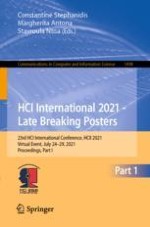2021 | OriginalPaper | Chapter
Developing Spatial Visualization Skills with Virtual Reality and Hand Tracking
Authors : Liam Stewart, Christian Lopez
Published in: HCI International 2021 - Late Breaking Posters
Publisher: Springer International Publishing
Activate our intelligent search to find suitable subject content or patents.
Select sections of text to find matching patents with Artificial Intelligence. powered by
Select sections of text to find additional relevant content using AI-assisted search. powered by
